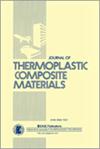合成二氧化钛纳米粒子增强的聚甲基丙烯酸甲酯/聚对苯二甲酸乙二醇酯混合物,用于牙科填料应用
IF 3.4
4区 材料科学
Q2 MATERIALS SCIENCE, COMPOSITES
引用次数: 0
摘要
本研究的目的是利用回收的废料来改变用作牙科填充物的复合材料的性能。为此,利用乙二醇工艺回收聚对苯二甲酸乙二酯(PET)废料,制备了解聚聚对苯二甲酸乙二酯(DPET)聚合物。然后按不同的重量百分比将 DPET 与聚甲基丙烯酸甲酯(PMMA)混合。对聚合物混合物进行了机械、物理和生物测试。结果表明,含有 5 重量百分比 DPET 的聚甲基丙烯酸甲酯表现出最高的抗压强度,约为纯聚甲基丙烯酸甲酯的两倍,这突出表明这些树脂适合替代汞合金,并可考虑用于牙科修复。研究还发现,当 DPET 含量为 5 wt% 时,混合物的吸水性相对稳定。扫描电子显微镜图像显示,DPET 和 PMMA 之间没有可区分的相位,这突出表明了 DPET 和 PMMA 之间的高度相容性。包括体外细胞毒性在内的生物测试表明,含有 5 wt% DPET 的 PMMA 的细胞存活率平均值高于对照组。有趣的是,在牙科实践中,可靠的体外细胞毒性方法被认为是临床程序中使用牙科填充系统的重要辅助手段。微生物学研究表明,PMMA:5 wt% DPET 对变异链球菌的抑制区高于对照组。根据所得结果,PMMA:5 wt% DPET 的混合物被选为最佳混合物,然后用不同重量百分比的纳米二氧化钛(TiO2)对其进行增强。然后对复合材料进行了压缩、显微硬度和冲击测试。结果表明,二氧化钛对提高所研究复合材料的性能有显著影响。这为牙科用纳米复合材料的合成提供了新的方案。本文章由计算机程序翻译,如有差异,请以英文原文为准。
Synthesis of polymethyl methacrylate/depolymerized polyethylene terephthalate blend reinforced by titanium dioxide nanoparticles for dental fillings applications
The aim of this study is to use recycled waste materials to modify the performance of composites used as dental fillings. For this purpose, depolymerized polyethylene terephthalate (DPET) polymers were prepared by recycling waste polyethylene terephthalate (PET) using the glycolysis process. DPET was then blended with polymethyl methacrylate (PMMA) at different weight percentages. Polymer blends were subjected to mechanical, physical, and biological tests. It is evident that PMMA blended with a 5 wt% of DPET exhibits the highest compressive strength which is approximately two times that obtained from neat PMMA, highlighting the suitability of these resins to replace amalgam and to be considered for dental restorations. It was also found that the water absorption of the blends investigated is relatively stable at 5 wt% DPET. The SEM images showed no distinguishable phases, highlighting the high compatibility between DPET and PMMA. The biological tests, including in vitro cytotoxicity, showed that the cell viability mean values of PMMA containing 5 wt% DPET is higher than that of control group. Interestingly, in dental practice, the reliable in vitro cytotoxic approach is considered as an important aid in clinical procedures in the use of dental filling systems. The microbiology study has shown that the inhibition zones against Streptococcus mutans of PMMA: 5 wt% DPET is higher than the control group. According to the obtained results, the blend of PMMA: 5 wt% DPET was selected as an optimum blend, which was then reinforced with various weight percentages of nano-sized titanium dioxide (TiO2). The composites were then tested under compression, microhardness, and impact tests. The results demonstrated the significant impact of TiO2 on enhancing the properties of the composites investigated. This can provide a new protocol for synthesizing nanocomposite materials for dentistry.
求助全文
通过发布文献求助,成功后即可免费获取论文全文。
去求助
来源期刊

Journal of Thermoplastic Composite Materials
工程技术-材料科学:复合
CiteScore
8.00
自引率
18.20%
发文量
104
审稿时长
5.9 months
期刊介绍:
The Journal of Thermoplastic Composite Materials is a fully peer-reviewed international journal that publishes original research and review articles on polymers, nanocomposites, and particulate-, discontinuous-, and continuous-fiber-reinforced materials in the areas of processing, materials science, mechanics, durability, design, non destructive evaluation and manufacturing science. This journal is a member of the Committee on Publication Ethics (COPE).
 求助内容:
求助内容: 应助结果提醒方式:
应助结果提醒方式:


